

Welcome To
The James Museum from Home
Connect with us through curated content based on our collection. Explore art, movies, books, music, children’s activities and more. Each theme is freshly considered and developed by our curatorial and education teams. We invite you to discover a new way to experience the museum and learn more about our collection.
Theme: Cowboys
Explore Cowboys through art, movies, books, music, children’s activities and more.
Selected Artwork
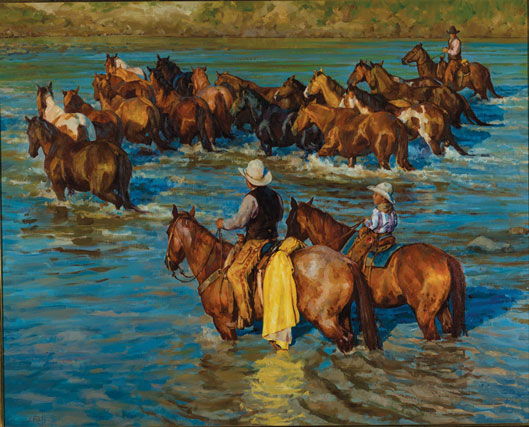
Jason Rich
American, born 1970
A Western Heritage
2008
Oil on canvas laid on foamcore
Art Spotlight
By: Caitlin Pendola | Curatorial Associate
“Every painting starts with the horse,” says Rich, who is an active member of the invitation only organization, Cowboy Artists of America (CAA). Growing up on a small horse farm in southern Idaho, Rich worked alongside his father, raising and training horses to sell. Today, he is a full-time artist, though he still rides with cowboys, working on ranches and going on trail rides to gain inspiration for his work.
As a young artist, one of the most valuable lessons Rich learned was the importance of a careful composition. In this painting, he directs the viewer’s eye across the canvas, successfully creating a sense of movement that echoes the movement of the horses and running water. Rich often uses soft edges and a strong contrast between darks and highlights. The result is vibrant, glowing color that seduces the eye and sets an idyllic mood which reinforces the romanticized image of cowboy culture.
Within the subject matter that Rich conveys in his paintings, are the values that he finds integral to life connected to the land, hard work and deep family bonds. He understands that cowboy traditions are often passed from one generation to the next. Here, a young man helps drive a team of horses alongside his father.
Crossing a river on horseback can be hazardous and training a horse to confidently cross water takes planning, patience, and practice. Not only are the techniques essential, but it also requires a close partnership between the cowboy and horse, working together to navigate the safest route.
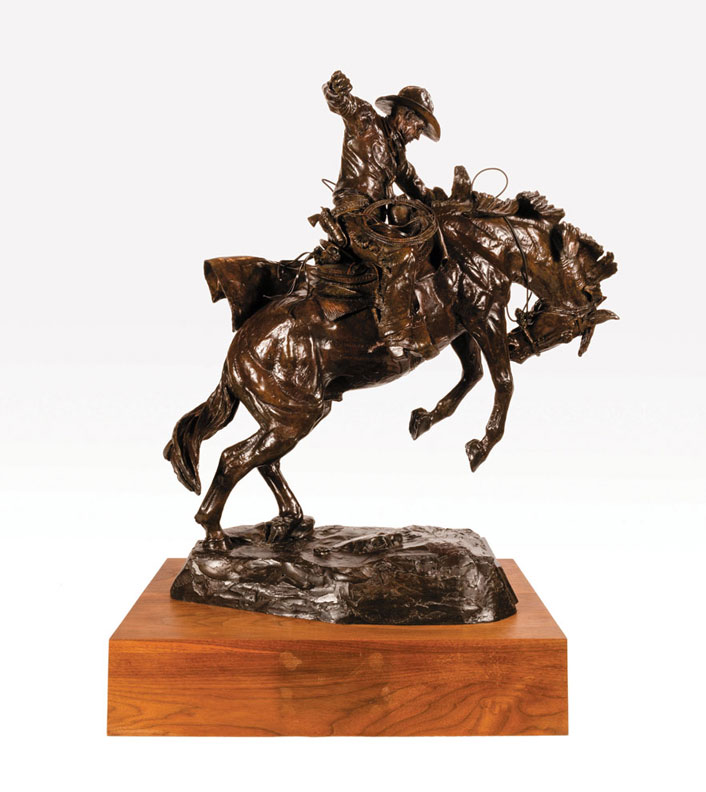
Fred Fellows
American, born 1934
An Honest Day’s Work
2008
Bronze, 44/50
Art Spotlight
By: Emily Kapes | Curator of Art
“In the vast reaches of the American West, the work ethic still exists. The man who makes his living on horses that are bound to buck, earns his pay. A good hand is loyal to his outfit, meets a challenge, and takes pride in an honest day’s work.”
– Fred Fellows
With long days working together, a cowboy and his horse often develop strong bonds. Their close partnership, ideally based on mutual respect, is crucial to getting the job done. Exceptions do occur though, as seen with this dramatic bronze sculpture called An Honest Day’s Work by Fred Fellows. You can see the rearing horse’s powerful muscles as the rider hangs on tight.
Horses stand up on their hind legs due to fear, aggression, surprise, or disobedience. It’s up to the cowboy to take back control by leaning forward, keeping the reins slack, and encouraging the horse to move forward.
The silhouette of a rearing horse and rider has been a definitive symbol of the American West since the late 1800s. The action captures the spirit and determination of early settlers and cowboys. It also shows the potential danger and unpredictability of the job.
Artist Fred Fellows has made a career of depicting what he knows and loves – western culture and all things cowboy. This Arizona rancher raises quarter horses and has participated in countless rodeo roping events. His art career has spanned six decades, and he is the longest running member of the prestigious Cowboy Artists of America. In addition to his veritable experience in the saddle, this sculpture was also likely inspired by a similar bronze made over 100 years ago—Frederic Remington’s famed Bronco Buster.
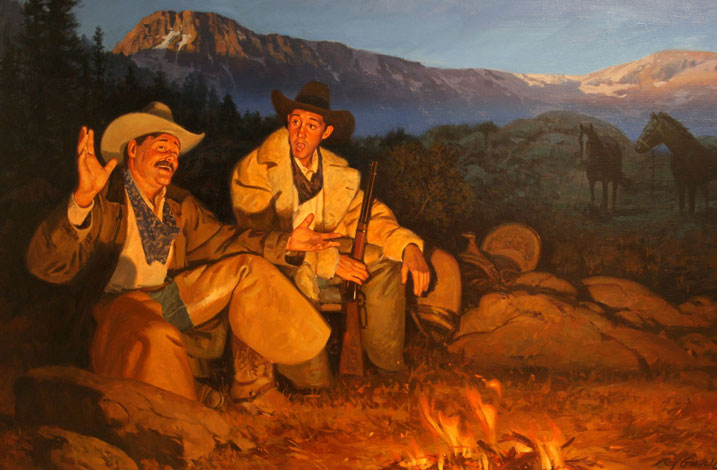
Roy Grinnell
American, born 1933
Mountain Lyin’ Tales
1994
Oil on canvas
Art Spotlight
By: Emily Kapes | Curator of Art
Grinnell was an artist known for versatility, painting aviation, wildlife and Western art subjects. After a stint in the Navy, he attended the Art Center School of Design in Los Angeles and became an illustrator in New York City.
In this campfire scene, sharing tall tales after a long day in the saddle was a fun way to pass the evening on the open range. The warm light from the fire highlights the cowboys’ exaggerated expressions.
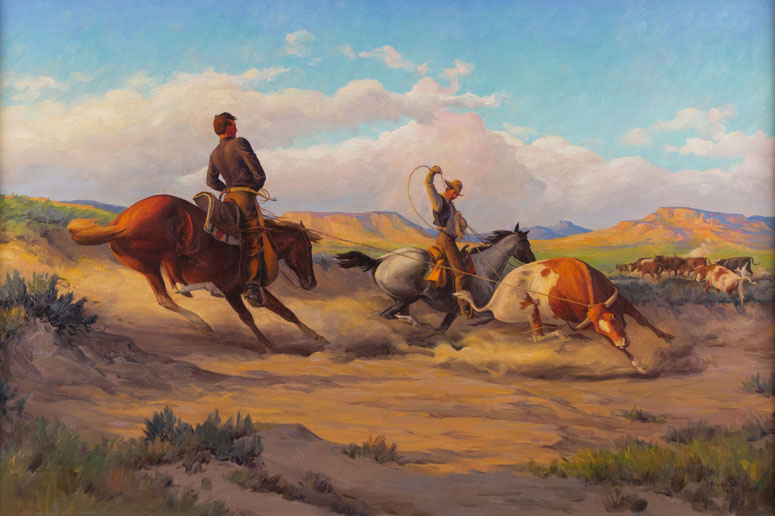
Irvin “Shorty” Shope
American, 1900–1977
Loose Cinch
1948
Oil on canvas
Art Spotlight
By: Jason M. Wyatt | Collections Manager
One learns basic information reading a wall label, including artist’s name, creation date, title and medium, with a short write-up of facts about the artist and the composition.
Much of this information comes from a Curator cataloging the piece by inspecting every surface to record as much information as possible. They also research the piece through books, articles, the internet and by contacting other scholars to gain information to share with the visitor.
This painting was cataloged earlier this year and new information was discovered. The work came into the collection as “Untitled”. When cardboard was removed from the back of the canvas the title, Loose Cinch, was found written on the stretcher. This refers to the horse’s saddle on the left side of the composition which is rising-up because it wasn’t tighten it properly. Another inscription on the stretcher gives the artist’s name and Helena, Mont. which leads us to believe the painting was created there.
We also discovered the painting was conserved at some point to repair a tear in the canvas. The current frame is not original as evidenced by empty nail holes in the stretcher and an inscription showing it was framed in California.
The artist’s signature and date are in the lower right corner along with a monogram depicting a circle and arrow. With research, we learned this is a reference to the Circle Arrow Ranch, where the artist was born.
Currently we are working to establish the provenance or record of ownership for this piece. We know before our founders acquired it in 2014 from Nelson Fine Art, it was owned by the Reserve National Insurance Company of Oklahoma who sold it at auction.
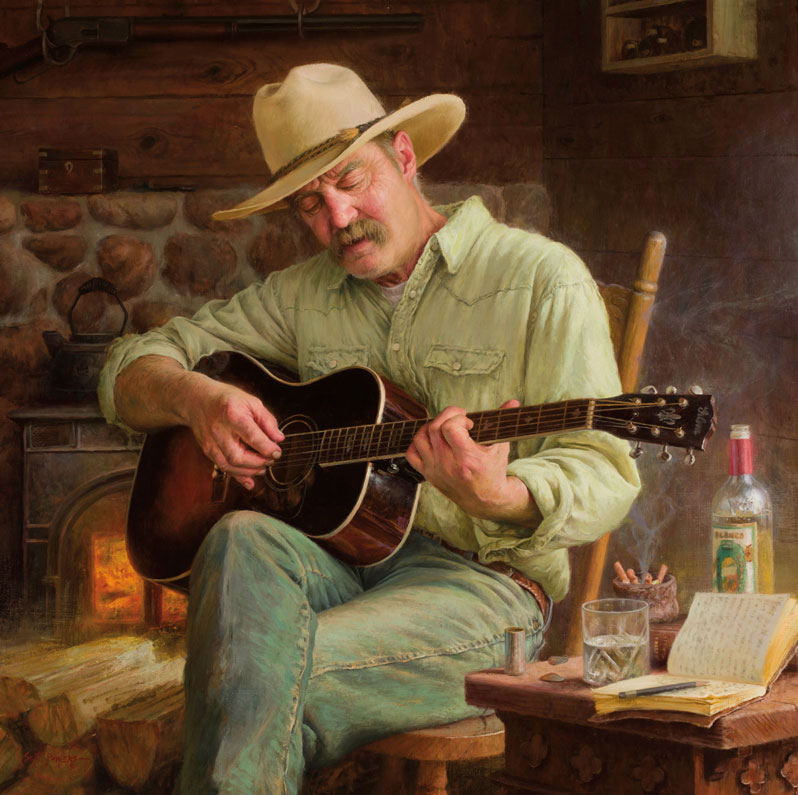
Scott Tallman Powers
American, born 1972
The Wyoming Storyteller
2015
Oil on canvas
Art Spotlight
By: Caitlin Pendola | Curatorial Associate
Scott Tallman Powers is not just a painter of the American West, but an interpreter of the world. A perpetual wanderlust, he travels the globe exploring people, searching for the underlying similarities between us all, rather than our differences. A connoisseur of the human spirit, it has been said that his “art captures the universal connections that span cultural divides of geography and time.”
Here, Powers has found inspiration in the Prairie Blues musician, Mike Hurwitz. Hurwitz grew up in the ranch country of Wyoming, surrounded by the diversity of the area at the time. His life and music are influenced by Mexican vaqueros, Shoshone and Arapoho ranchhands, Basque sheepherders, Scandinavian loggers, Scottish cattlemen, and many other people he lived and worked alongside. It seems fitting that these two versed artists would come together for this portrait.
Hurwitz says, “Winters in the mountains can get pretty old. Sometimes sitting by a warm fire with an old guitar and a bottle you might get lucky, and the words and melodies slide like snow off a tin roof.” Powers has rendered this described scene with soft, muted tones and an understated background to capture the mellow and musing essence Hurwitz has recounted. Getting to know his subjects before he paints them is one of the qualities that allows Powers to interpret with great honesty and sensitivity.

Art Spotlight
By: Jason M. Wyatt | Collections Manager
Jackson’s sculpture, cast at the artist’s foundry in Camaiore, Italy, celebrates the Wyoming rodeo champion Clayton Danks (1879-1970) and the first nationally known bucking rodeo horse Steamboat (1896-1914).
Steamboat got his name after a ranch accident in 1899. He broke a bone in his nose that had to be removed leaving him with a high-pitched sound to his breathing when he became agitated. He began his rodeo career in 1901 and quickly gained a reputation as one of the toughest horses to ride because of his violent bucking, stiff-legged landings, and stamina. Steamboat’s notoriety also came from his tendency for Sunfishing; a term used to describe when a horse jumps into the air twisting its body to one side, kicking out its legs as seen in this sculpture.
Danks began riding professionally in 1899, and in 1902 rode Steamboat for the first time at a competition in Laramie. From 1902 until Steamboat’s death in 1914, Danks rode the horse in many competitions, winning three, one of which was the World Championship at the Cheyenne Frontier Days competition in 1909. When Danks was asked why Steamboat was so hard to ride he said, “It’s the way he hits the ground. There are other bucking horses that do more fancy pitching, but Steamboat just keeps his head down and just fights. When he gives one of those peculiar, twisting jumps and comes down stiff-legged, the man is rocked something painful. I had my head snapped back until I thought it was going to come off, and I felt as if my lungs were going to burst when I had ridden that horse for a few jumps.” Clayton Danks retired from the rodeo after the death of Steamboat saying, “When Steamboat’s day was over, I think a part of rodeo ended for me to.”
Harry Jackson
American, 1924-2011
Two Champs
1978
Bronze (TCF7)
Movies
These short documentaries and feature-length films offer diverse perspectives on life in the West, and an expansive look at what it means to be a cowboy (and cowgirl).
Feature Films
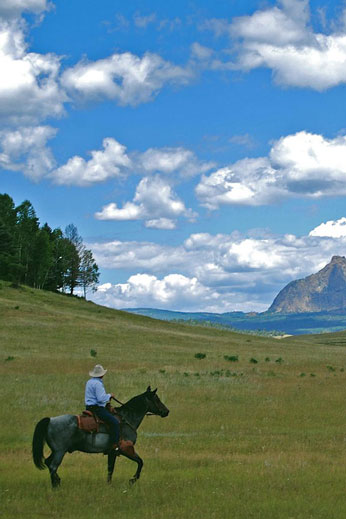
Everything in the Song is True (2016)
Spanning wide open spaces from New Mexico to South Dakota, this warm and humorous documentary follows four colorful characters whose music, art, and way of life are a celebration of Western folk culture. Their songs and deeds speak to a powerful connection to the land, animals, and values that are uniquely American, even as modern life continues to transform the landscape. NR; 83 min.
The Rider (2018)
This critically acclaimed drama is based on the true story of a young Lakota cowboy Brady Jandreau, once a rising star of the rodeo circuit in South Dakota. After suffering a near fatal injury, he is warned that his competition days are over, and he struggles in search of a new identity. Rated R; 104 min.
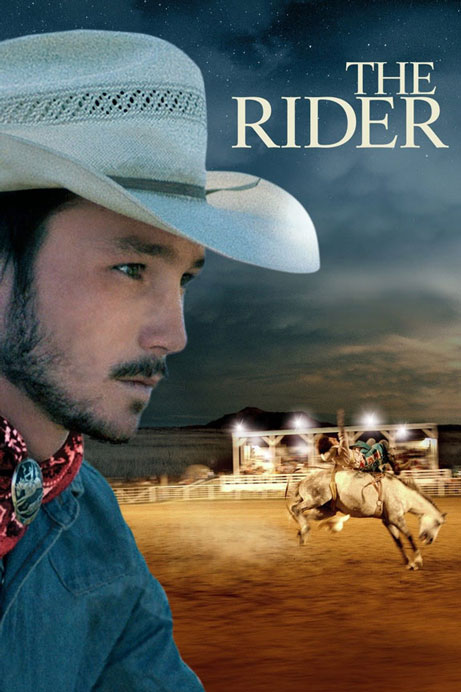
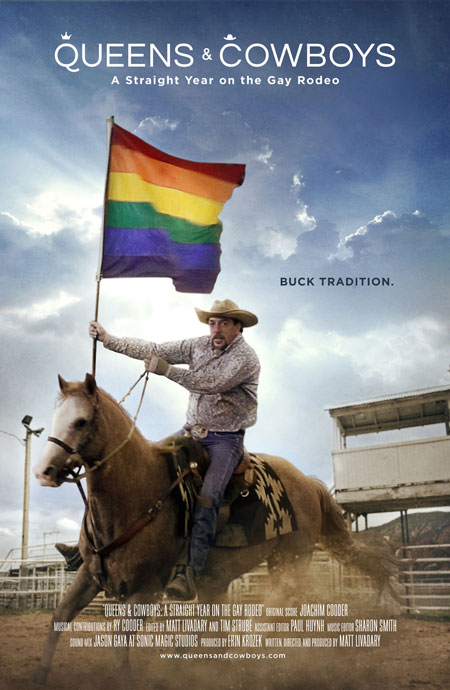
Queens & Cowboys: A Straight Year on the Gay Rodeo (2018)
This film chronicles a complete season of the International Gay Rodeo Association (IGRA). Roping and riding across North America, the IGRA’s courageous cowboys and cowgirls brave challenges both in and out of the arena on their quest to qualify for the World Finals at the end of the season. Along the way, they’ll bust every stereotype in the book. NR; 92 min.
Short Films
When the territory now known as Texas was part of the Spanish empire, Spanish cowboys – or vaqueros – developed the ranching industry in South Texas, including the various techniques and tools of the trade that came to be associated with the American cowboy. (3:47 min)
Thousands of miles west of United States’ mainland you’ll find the legendary paniolo – the cowboys of Hawaii. What began with a gift of a few cows and a bull to the King in the 1700s has grown into a ranching community that has passed down their hunting, cowboying, and fishing traditions for generations. (6:09 min)
This short documentary tells the story of African American rodeo cowboys in the 1950s to 1970s. Rodeos in the South were segregated until 1970s, and the cowboys in the documentary share their personal experiences about this tumultuous time. (14:00 min)
He grew up on the Navajo reservation with little else besides family, livestock, and his grandfather’s prayer. Derrick Begay has since gone on to take his place as one of the best cowboys around and paved the way for generations of Navajo cowboys to come. (10:29 min)
While the movie Brokeback Mountain won an Oscar, there’s often still a stigma against being gay and a cattle wrangler. Fortunately, the International Gay Rodeo Association is working to change that. Their events highlight the serious riding and roping talents of LGBT cowfolks, and provide a safe, supportive and fun environment for them to pursue their passion. (P)ride on! (2:16 min)
In a sport dominated by white men, the all-female, all-black team is a rarity. At the Bill Pickett rodeo, the only black rodeo in the country, high-octane events such as bull riding and steer wrestling remain almost exclusively male. But every year brings more female contestants than the last. (5:56 min)
Books
The James Museum Book Club Recommends…
The Last Cowboys: A Pioneer Family in the New West
By John Branch
A Pulitzer Prize-winning journalist for the New York Times, John Branch spent three years following the Wright family of southern Utah—out on the range, rounding up and branding cattle, and on the rodeo circuit. The Wrights are more interesting than your average ranch family. Many of them are or were champion rodeo riders. Although the Wrights have been ranching in Utah for 150 years, they face serious challenges today, including drought, urban encroachment, low beef prices, and controversies over the use of public lands. Neighboring Zion National Park is one of the country’s most popular parks, attracting more than four million visitors a year, creating both problems and opportunities for the Wrights.

Helen Huntley
Book Club Discussion Leader
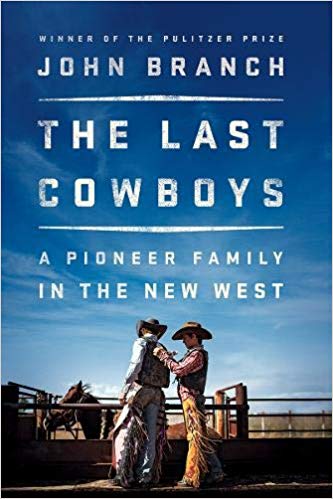
Additional Resources:
Although we can’t gather to discuss The Last Cowboys: A Pioneer Family in the New West, book club discussion leader Helen Huntley has developed a discussion guide for you to use at home.
Meet Bill Wright and his seven sons as they run the family’s 800-acre cattle ranch in southern Utah. The Wrights are true cowboys, driving cattle to grazing lands across Utah and using a combination of horses and diesel pick-ups to get the job done. (5:31 min.)
Family owned for six generations. You can visit the Zion Wright Family Ranch for an off-the-grid experience with breath-taking views of Kolob, Smith Mesa, and Zion National Park.
Story Time
Why Cowboys Sleep with Their Boots On
By Laurie Lazzaro Knowlton
Art Activity
Slithering Paper Snake
Learn how to make your own paper snake inspired by the book, Why Cowboys Sleep with Their Boots On, by Laurie Lazzaro Knowlton.
Just for Fun
Games
The Oregon Trail
While we know this doesn’t exactly fit into the Cowboys theme, we thought you might enjoy a little bit of computer game nostalgia. Popular from the mid-1980s to mid-2000s, the original Oregon Trail game was designed to teach school children about the realities of 19th-century pioneer life on the Oregon Trail. The player assumes the role of a wagon leader guiding a party of settlers from Independence, Missouri, to Oregon’s Willamette Valley via a covered wagon in 1848.
Music
Dom Flemons presents: Black Cowboys
A collection of seldom-heard stories about the roles African Americans played in settling the West after America’s Civil War.
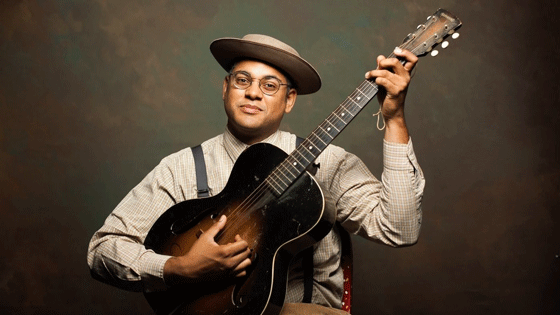
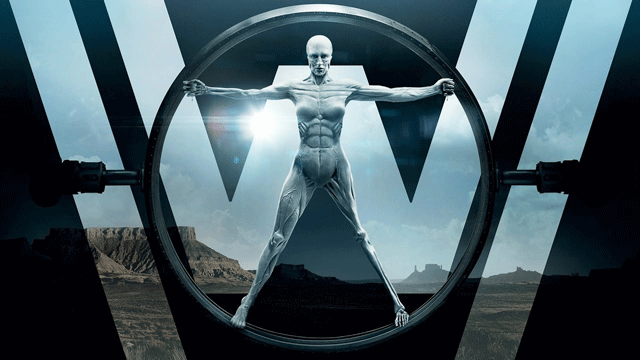
Westworld, Composed by Ramin Djawadi
Hear the soundtrack from the acclaimed HBO series Westworld.